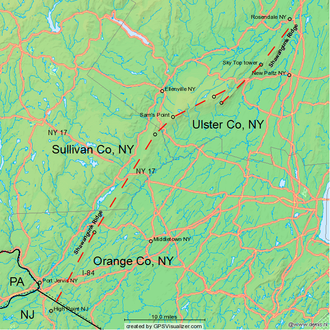| Shawangunk Ridge | |
|---|---|
| Shawangunk Mountains | |
 Shawangunk Ridge from Sky Top cliff | |
| Highest point | |
| Peak | High Point |
| Elevation | 2,289 ft (698 m) |
| Coordinates | 41°42′14″N 74°20′41″W / 41.70389°N 74.34472°W |
| Dimensions | |
| Length | 47 mi (76 km) north–south |
| Geography | |
 | |
| Country | United States |
| State | New York |
| Geology | |
| Rock age | Silurian (440 to 417 (±10) million years ago) |
| Rock type(s) | Shawangunk Formation; sedimentary |

The Shawangunk Ridge /ˈʃɑːwəŋɡʌŋk/, also known as the Shawangunk Mountains or The Gunks,[1] is a ridge of bedrock in Ulster County, Sullivan County and Orange County in the state of New York, extending from the northernmost point of the border with New Jersey to the Catskills. The Shawangunk Ridge is a continuation of the long, easternmost section of the Appalachian Mountains; the ridge is known as Kittatinny Mountain in New Jersey, and as Blue Mountain as it continues through Pennsylvania. This ridge constitutes the western border of the Great Appalachian Valley.

The ridgetop, which widens considerably at its northern end, has many public and private protected areas, including Wurtsboro Ridge State Forest, Shawangunk Ridge State Forest, Minnewaska State Park Preserve, Witch's Hole State Park and Mohonk Preserve. The ridge is not heavily populated; its only settlement of consequence is the hamlet of Cragsmoor. In the past, the ridge was chiefly noted for mining and logging and a boom-era of huckleberry picking. Fires were regularly set to burn away the undergrowth and stimulate new growth of huckleberry bushes.
Today the ridge has become known for its outdoor recreation, most notably as one of the major rock climbing areas of North America, with many guides offering rock climbing trips in the area. Also known for its biodiversity and scenic character, the ridge has been designated by The Nature Conservancy as a significant area for its conservation programs.[2]
- ^ Cite error: The named reference
Swainwas invoked but never defined (see the help page). - ^ Eastern: Shawangunk Mountains, The Nature Conservancy
